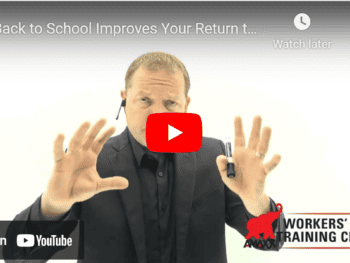A functional capacity evaluation (FCE) is a comprehensive series of test administered by an occupational therapist or a physical therapist who has had specialized training in performing a FCE. The tests are specifically designed to measure:
- stamina
- dynamic strength
- mobility
- flexibility
- body mechanics
- cardiovascular condition
- balance
- coordination
- dexterity
- ability to tolerate functional activities
Used to Determine Employee’s Readiness to Return to Work
In workers’ compensation claims, a functional capacity evaluation is often utilized to determine the injured employee’s physical readiness to return to work and to measure any physical limitations the employee will have as a result of the work comp injury. A FCE can also be utilized to determine the injured employee’s physical capabilities for vocational retraining when the injured employee will be permanently unable to return to his/her prior vocation.
A functional capacity evaluation can be one of two types, either a job-specific FCE or a general purpose FCE. In a job-specific FCE, the therapist is provided a detailed job description prior to the testing in order to tailor the FCE to the specific job of the employee. To have a very accurate FCE, the therapist should visit the job site to have a detailed understanding of the functions of the job. In a general-purpose functional capacity evaluation, the testing measures the employee’s strength and tolerance in completing standardized or common work task.
Click Link to Access Free PDF Download
“13 Research Studies to Prove Value of Return-to-Work Program & Gain Stakeholder Buy-In”
Test Can Last Several Hours to Two Days
After a determination of the type of FCE, the appointment date is scheduled for the injured employee. An FCE can last from several hours to two days, depending on the nature and extent of testing.
At the start of the functional capacity evaluation, the therapist will perform a comprehensive interview of the injured employee. The interview is designed to identify any factors that could impact the employee’s ability to participate in the FCE. The therapist will want to know if the employee has any issues with asthma, COPD or other lung/breathing problems, high blood pressure, physical limitations besides the work comp injury, and obtain the employee’s own assessment of their physical condition including the employee’s perception of his/her pain level.
Measure Various Physical Tests
In conjunction with the interview, the therapist will complete a clinical assessment of the employee to establish a baseline for the FCE. The therapist will measure the employee’s range of motion, balance, grip strength and coordination to establish the testing plan.
In a job-specific FCE the therapist will measure the employee’s ability to lift, carry and perform other tasks in comparison to the performance levels identified in the employee’s job description guidelines. In the general purpose FCE, the therapist will measure the employee’s maximum ability to lift, carry and perform routine work-related task.
5 Categories of Physical Demands
The U.S. Department of Labor characterizes jobs in 5 categories depending on the physical demands of the job. For instance, an over-the-road, or long-haul truck driver is classified as a “heavy” physical demanding job. The 5 categories are defined as:
- Sedentary: exerting up to 10 pounds of force occasionally
- Light: exerting up to 20 pounds of force occasionally or up to 10 pounds of force frequently
- Medium: exerting 20 to 50 pounds of force occasionally or 10 to 25 pounds of force frequently
- Heavy: exerting 50 to 100 pounds of force occasionally or 25 to 50 pounds of force frequently
- Very Heavy: exerting in excess of 100 pounds of force occasionally or in excess of 50 pounds of force frequently or in excess of 20 pounds of force constantly
If the therapist is performing a general purpose functional capacity evaluation on a truck driver, the therapist would determine the truck driver’s job is a “heavy” physically demanding job. The general purpose FCE testing would measure the employee’s ability to meet the requirements of the “heavy” job classification. However, some truck drivers are “drive and drop” drivers where they never touch the cargo. The hardest part of their job is cranking the landing gear of the trailer up and down and disconnecting the fifth-wheel. Their job requirements would fall in the “medium” job classification for physically demanding. Therefore, when there can be different levels of physical effort needed for a job title, it is to both the employer’s and the employee’s benefit to provide a detailed job description to the therapist and to request a job-specific FCE.
FREE DOWNLOAD: “13 Research Studies to Prove Value of Return-to-Work Program & Gain Stakeholder Buy-In”
Biggest Issue is Validity of Effort by Injured Employee
The biggest issue with FCE is the validity of the effort put forth by the injured employee. If the injured employee has been advised by his/her attorney that the better they do on the FCE, the lower their permanent partial disability settlement will be, the employee is given a financial incentive to put forth less than their best effort. If there is any concern the employee may not make a sincere effort in the FCE, the therapist should be advised prior to the FCE. The therapist can give the employee several different tasks or activities that measure the same physical ability. If the test results reflect a variation in the employee’s ability within a specific category when measured by two or more different methods, the therapist will be able to identify the employee who is trying to game the testing and include in their post testing report the fact that the effort put forth by the employee was inconsistent.
Results Compared Against Specific Job Description
When the FCE testing is completed, the therapist will compile the employee’s test results. The test results will be compared against the specific job description requirements or the general physical level classification of a job to see if the employee can return to performing the job. The results of the FCE are then reported to the treating doctor and workers’ compensation adjuster and/or nurse case manager.

Author Michael Stack, CEO Amaxx LLC. He is an expert in workers’ compensation cost containment systems and helps employers reduce their workers’ comp costs by 20% to 50%. He works as a consultant to large and mid-market clients, is a co-author of Your Ultimate Guide To Mastering Workers Comp Costs, a comprehensive step-by-step manual of cost containment strategies based on hands-on field experience, and is founder & lead trainer of Amaxx Workers’ Comp Training Center .
Contact: mstack@reduceyourworkerscomp.com.
Workers’ Comp Roundup Blog: https://blog.reduceyourworkerscomp.com/
©2019 Amaxx LLC. All rights reserved under International Copyright Law.
Do not use this information without independent verification. All state laws vary. You should consult with your insurance broker, attorney, or qualified professional.
















 6 Ways Insurance Companies Control Workers’ Comp Claim Leakage
6 Ways Insurance Companies Control Workers’ Comp Claim Leakage
